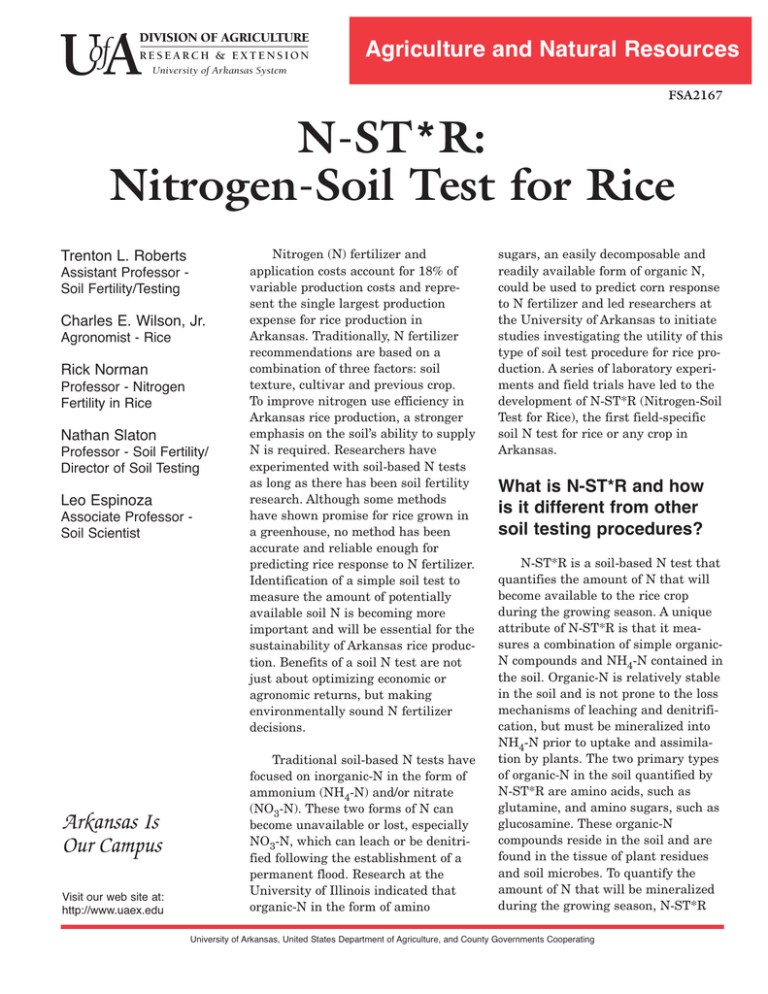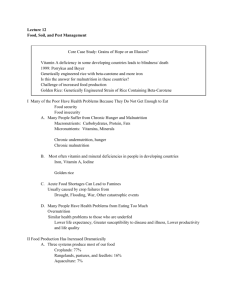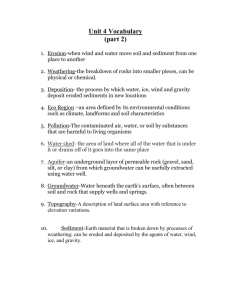Document 12187343
advertisement

DIVISION OF AGRICULTURE RESEARCH & EXTENSION Agriculture and Natural Resources University of Arkansas System FSA2167 N-ST*R: Nitrogen-Soil Test for Rice Trenton L. Roberts Assistant Professor ­ Soil Fertility/Testing Charles E. Wilson, Jr. Agronomist - Rice Rick Norman Professor - Nitrogen Fertility in Rice Nathan Slaton Professor - Soil Fertility/ Director of Soil Testing Leo Espinoza Associate Professor ­ Soil Scientist Arkansas Is Our Campus Visit our web site at: http://www.uaex.edu Nitrogen (N) fertilizer and application costs account for 18% of variable production costs and repre­ sent the single largest production expense for rice production in Arkansas. Traditionally, N fertilizer recommendations are based on a combination of three factors: soil texture, cultivar and previous crop. To improve nitrogen use efficiency in Arkansas rice production, a stronger emphasis on the soil’s ability to supply N is required. Researchers have experimented with soil-based N tests as long as there has been soil fertility research. Although some methods have shown promise for rice grown in a greenhouse, no method has been accurate and reliable enough for predicting rice response to N fertilizer. Identification of a simple soil test to measure the amount of potentially available soil N is becoming more important and will be essential for the sustainability of Arkansas rice produc­ tion. Benefits of a soil N test are not just about optimizing economic or agronomic returns, but making environmentally sound N fertilizer decisions. Traditional soil-based N tests have focused on inorganic-N in the form of ammonium (NH4-N) and/or nitrate (NO3-N). These two forms of N can become unavailable or lost, especially NO3-N, which can leach or be denitri­ fied following the establishment of a permanent flood. Research at the University of Illinois indicated that organic-N in the form of amino sugars, an easily decomposable and readily available form of organic N, could be used to predict corn response to N fertilizer and led researchers at the University of Arkansas to initiate studies investigating the utility of this type of soil test procedure for rice pro­ duction. A series of laboratory experi­ ments and field trials have led to the development of N-ST*R (Nitrogen-Soil Test for Rice), the first field-specific soil N test for rice or any crop in Arkansas. What is N-ST*R and how is it different from other soil testing procedures? N-ST*R is a soil-based N test that quantifies the amount of N that will become available to the rice crop during the growing season. A unique attribute of N-ST*R is that it mea­ sures a combination of simple organicN compounds and NH4-N contained in the soil. Organic-N is relatively stable in the soil and is not prone to the loss mechanisms of leaching and denitrifi­ cation, but must be mineralized into NH4-N prior to uptake and assimila­ tion by plants. The two primary types of organic-N in the soil quantified by N-ST*R are amino acids, such as glutamine, and amino sugars, such as glucosamine. These organic-N compounds reside in the soil and are found in the tissue of plant residues and soil microbes. To quantify the amount of N that will be mineralized during the growing season, N-ST*R University of Arkansas, United States Department of Agriculture, and County Governments Cooperating uses a steam distillation procedure that involves intense heat and highly concentrated sodium hydrox­ ide. The amount of N that is released during the steam distillation procedure is used as an index of soil N availability, which is highly correlated to rice N uptake and grain yield. The steam distillation pro­ cedure is somewhat labor intensive and cannot be cost effectively automated like some routine soil analysis procedures such as soil pH. Comparison of N-ST*R to other soil-based N tests such as soil total N and the pre-sidedress nitrate test (PSNT) reveals some unique differences. When compared to soil total N, N-ST*R is much more specific and only quan­ tifies 8% to 25% of the total N contained in the soil, depending on the soil’s native N fertility. On the other hand, N-ST*R quantifies more compounds than the PSNT, which estimates only the amount of NO3-N in the soil and can have extreme spatial and temporal variability within fields due in large part to its high potential for loss via leaching or denitrifica­ tion. A portion of N-ST*R’s success must be attrib­ uted to its unique ability to selectively quantify soil organic-N compounds which are readily mineralizable for plant N uptake and contribute to rice growth and yield. Why is N-ST*R successful in rice? Properly managed, direct-seeded, delayed-flood rice culture boasts one of the highest N use efficien­ cies (NUE) of any crop production system, which means that our production system allows more of the fertilizer N to be taken up and used by the rice crop. Coupled with the high NUE of rice is the fact that when best management practices are used, direct-seeded, delayed-flood rice will have a pre­ dictable NUE which has been reported to be as high as 65% to 75%. The use of ammonium-based (NH4) fertilizers as well as timely flooding to prevent nitrifi­ cation/denitrification significantly limits the potential for N fertilizer losses, resulting in more of the applied N being available for rice uptake. Another interesting aspect of the direct-seeded, delayed-flood production system is how the establishment of a permanent flood helps to moderate temperature and maintain soil moisture and oxygen levels, allowing a consistent mineralization rate of soil organic-N. The success of N-ST*R for rice has been largely influenced by the high and consistent NUE which is directly tied to proper flood management. The use of a urease inhibitor such as NBPT, timely flooding following preflood N application and the maintenance of adequate flood depths for 4 weeks following establishment of a permanent flood will be critical when using N-ST*R technology. Why canʼt I use a 4-inch soil sample? Proper soil sampling depth is a key component of N-ST*R’s success and can be attributed to the effec­ tive rooting depth of rice. Arkansas research has shown rice roots may grow to a depth of 24 inches, suggesting that roots may take up nutrients present in the subsoil. Initially, researchers at the University of Arkansas attempted to use a 6-inch soil sample to correlate and calibrate rice yield response with N-ST*R, but the relationship was poor and could not be used effectively to predict field-specific N rates. Before abandoning the procedure, soil samples were taken to a 24-inch soil depth in 6-inch increments to determine if sample depth would improve the correla­ tion. The results indicated that by sampling 18 inches deep we could accurately predict the N needs of rice produced on silt loam soils 89% of the time. Currently, research is ongoing for rice produced on clay soils, but it appears that the proper sampling depth for clay soils will be 12 inches. Research has shown that a large amount of N can exist at depths >6 inches, and rice appears to be taking advantage of a significant portion of the sub­ soil N. A key point to remember is that the proper soil sampling depth is directly related to the accuracy of the soil testing procedure and the nutrient being analyzed. Since N-ST*R uses a completely different soil testing procedure and is determining specific forms of N, it requires a different soil sample depth than routine tests for P and K availability in order to make a precise and accurate N rate recommendation. The development of N-ST*R technology for wheat has shown a soil sample only to a 6-inch depth is required. Corn, on the other hand, may require a different soil sampling depth entirely. In the future, as technology changes and we continue to research soil N dynamics, there is a possibility that new soil test procedures will require alternate soil sampling depths based on the type of soil test procedure being used. Will N-ST*R increase rice yields? The purpose of N-ST*R is to provide field-specific N rates that will ensure proper N rates are being applied on a field-by-field basis to achieve optimum rice yields. There are two distinct cases where N-ST*R has the potential to increase rice yields over the standard N rate recommended based on soil texture, variety and previous crop: (1) if native soil N is very high or (2) if native soil N is very low. Field validation research has shown that N-ST*R Table 1. Comparison of N-ST*R fertilizer N rate recommendations and the corresponding rice grain yield for three small-plot validation sites in 2010. Site 1 Treatment Site 2 Site 3 N Rate (units N/acre) Yield (bu/acre) N Rate (units N/acre) Yield (bu/acre) N Rate (units N/acre) Yield (bu/acre) Check 0 184 b 0 74 c 0 100 b N-ST*R 75 193 a 165 177 a 120 201 a Std. Rec. 150 167 c 150 161 b 150 210 a Rice yields within a site not sharing the same letter are significantly different at the p<0.05 probability level. recommendations can increase rice yields in fields that are naturally high in native soil N because the standard N rate (e.g., 150 lb N/acre for silt loam soil following soybean) often results in yield reductions due to disease and lodging exacerbated by excess N fertilizer (Table 1). When native soil N is high, the rice crop is able to maximize yield with significantly less fertilizer N because of what is being supplied by the soil. In these cases, rice yields can be maximized with lower N rates, and use of lower N rates reduces lodging, disease pressure and production costs associated with over-fertilization. Site 1 (Table 1) is an example of a field where rice yield was increased by using less N fertilizer. Site 2 is an example of the second situation where very low native N in the soil supplied too little N for the growing rice crop and the standard recommendation was not adequate to maxi­ mize yield. A significant increase in yield over the standard recommendation occurred when more fertil­ izer N was applied. Although these two scenarios may be atypical, the potential exists for rice yield to be increased by utilizing N-ST*R. inputs and maximizing rice yields using N-ST*R can only be accomplished when other nutrients such as P, K, S and Zn are sufficient for optimal rice growth. We expect that the N-ST*R predicted N rates will be relatively close (± 20 to 30 lb N/acre) to the standard recommendation in many fields, since the standard N rate likely represents the vast majority of rice fields. Thus, the yield potential in many fields, like Site 3 (Table 1), will not be appreciably affected in fields where the N-ST*R predicted N rate is similar to the standard recommendation. Small reductions in the amount of N fertilizer recommended per acre have the potential to significantly increase profitability when the savings are realized across an entire farm. The goal of the N-ST*R program is to provide field-specific N rates that will maximize productivity and profitability in regard to your N fertilizer program. Routine soil analysis for P, K, S and Zn availability should continue to be a producer priority when using N-ST*R. Optimizing N fertilizer The Nitrogen-Soil Test for Rice or N-ST*R is a newly developed soil-based N test that will be avail­ able to growers for rice produced on silt loam soils in Arkansas beginning in October 2011 and for clay soils within the next two to three years. What makes N-ST*R different is the ability to quantify a portion of the soil organic-N and NH4-N contained in the soil, which will become available to the rice crop during the growing season. By providing an index of native soil N availability, N-ST*R was correlated and cali­ brated to predict the field-specific N rates required to maximize rice yield and producer profitability. In order to effectively use N-ST*R, farmers must continue to use best N management practices, such as use of a urease inhibitor on preflood N, rapidly flooding fields after preflood N is applied and maintaining the flood for at least 4 weeks following When will N-ST*R be available for me to use? Correlation and calibration curves have been developed and validated for rice produced on silt loam soils in Arkansas. Work is ongoing to complete the correlation and calibration curves for rice pro­ duced on clay soils and should be available to producers during the fall of 2013. During the fall and winter of 2011-2012, soil samples will be accepted on a first-come, first-served basis for Arkansas rice producers interested in using N-ST*R for their rice produced on silt loam soils. Work is also underway to develop a test for wheat that is similar to N-ST*R and should be available in the next one to two years. Summary N fertilizer application to maximize crop use of soil and fertilizer N. N-ST*R has the potential to increase rice yields in some fields that are currently under- or over-fertilized and decrease N fertilizer use and costs in fields that are currently being over-fertilized. The goal of N-ST*R is to increase the productivity, prof­ itability and long-term sustainability of Arkansas rice production by providing field-specific N fertilizer management recommendations. Selected Reading Beyrouty, C. A., B. R. Wells, R. J. Norman, J. N. Marvel and J. A. Pillow, Jr. 1987. Characteriza­ tion of rice roots using a minirhizotron technique. p. 99-108. In H. M. Taylor (ed.) Minirhizotron observation tubes: Methods and applications for measuring rhizosphere dynamics. ASA Spec. Publ. 50. ASA, Madison, WI. Mulvaney, R. L., S. A. Khan and T. R. Ellsworth. 2006. Need for a soil-based approach in managing nitrogen fertilizers for profitable corn production. Soil Sci. Soc. Am. J. 70:172-182. Roberts, T. L., R. J. Norman, N. A. Slaton and C. E. Wilson, Jr. 2009. Changes in alkaline hydrolyz­ able nitrogen distribution with soil depth: Fertilizer correlation and calibration implications. Soil Sci. Soc. Am. J. 73:2151-2158. Wilson, C. E., Jr., R. J. Norman and B. R. Wells. 1989. Seasonal uptake patterns of fertilizer nitrogen applied in split applications to rice. Soil Sci. Soc. Am. J. 53:1884-1887. Printed by University of Arkansas Cooperative Extension Service Printing Services. DR. TRENTON L. ROBERTS is assistant professor - soil fertility/testing, DR. RICK NORMAN is professor - nitrogen fertility in rice and DR. NATHAN SLATON is professor - soil fertility/director of soil testing, Crop, Soil and Environmental Sciences at the University of Arkansas, Fayetteville. DR. CHARLES E. WILSON, JR., is agronomist - rice and director of the Rice Research and Extension Center, Stuttgart. DR. LEO ESPINOZA is Extension associate professor - soil scientist in Little Rock. All are employees of the University of Arkansas Division of Agriculture. FSA2167-PD-10-11N Issued in furtherance of Cooperative Extension work, Acts of May 8 and June 30, 1914, in cooperation with the U.S. Department of Agriculture, Director, Cooperative Extension Service, University of Arkansas. The Arkansas Cooperative Extension Service offers its programs to all eligible persons regardless of race, color, national origin, religion, gender, age, disability, marital or veteran status, or any other legally protected status, and is an Affirmative Action/Equal Opportunity Employer.




